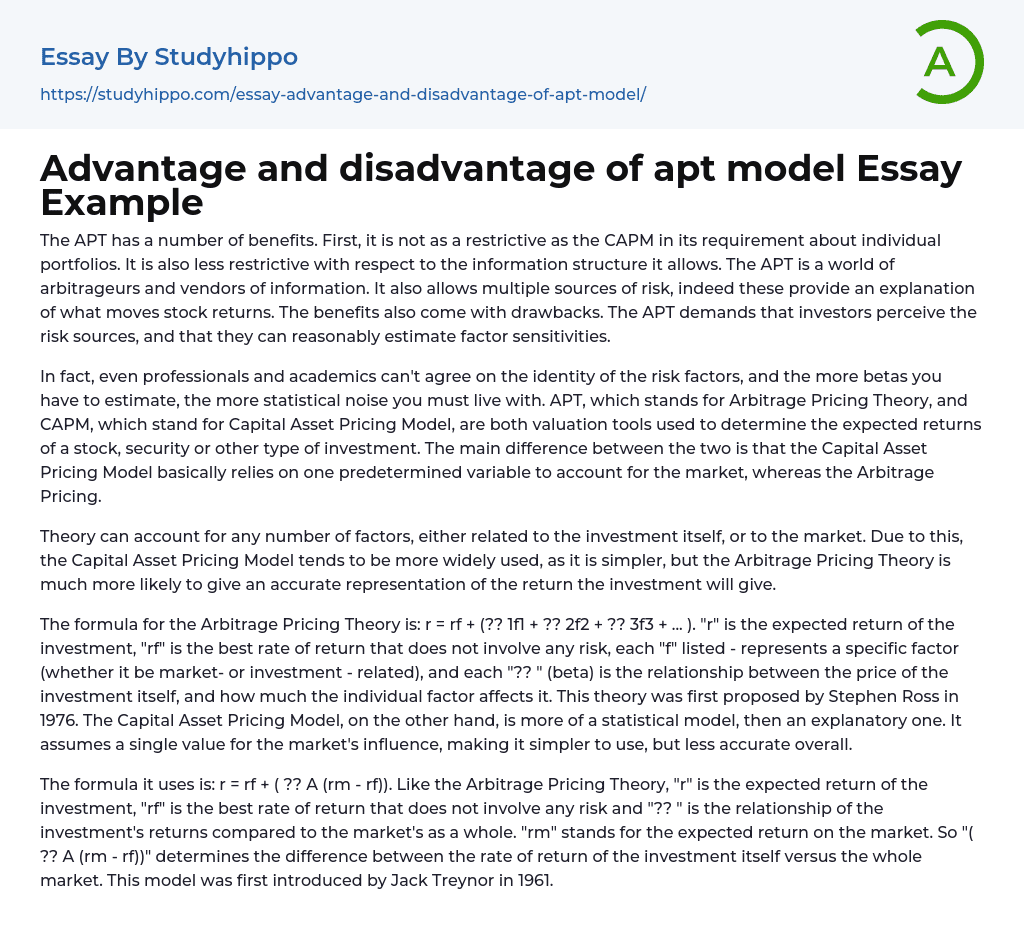The APT has a number of benefits. First, it is not as a restrictive as the CAPM in its requirement about individual portfolios. It is also less restrictive with respect to the information structure it allows. The APT is a world of arbitrageurs and vendors of information. It also allows multiple sources of risk, indeed these provide an explanation of what moves stock returns. The benefits also come with drawbacks. The APT demands that investors perceive the risk sources, and that they can reasonably estimate factor sensitivities.
In fact, even professionals and academics can't agree on the identity of the risk factors, and the more betas you have to estimate, the more statistical noise you must live with. APT, which stands for Arbitrage Pricing Theory, and CAPM, which stand for Capital
...Asset Pricing Model, are both valuation tools used to determine the expected returns of a stock, security or other type of investment. The main difference between the two is that the Capital Asset Pricing Model basically relies on one predetermined variable to account for the market, whereas the Arbitrage Pricing.
Theory can account for any number of factors, either related to the investment itself, or to the market. Due to this, the Capital Asset Pricing Model tends to be more widely used, as it is simpler, but the Arbitrage Pricing Theory is much more likely to give an accurate representation of the return the investment will give.
The formula for the Arbitrage Pricing Theory is: r = rf + (?? 1f1 + ?? 2f2 + ?? 3f3 + ... ). "r" is the expected return of the investment, "rf" is
the best rate of return that does not involve any risk, each "f" listed - represents a specific factor (whether it be market- or investment - related), and each "?? " (beta) is the relationship between the price of the investment itself, and how much the individual factor affects it. This theory was first proposed by Stephen Ross in 1976. The Capital Asset Pricing Model, on the other hand, is more of a statistical model, then an explanatory one. It assumes a single value for the market's influence, making it simpler to use, but less accurate overall.
The formula it uses is: r = rf + ( ?? A (rm - rf)). Like the Arbitrage Pricing Theory, "r" is the expected return of the investment, "rf" is the best rate of return that does not involve any risk and "?? " is the relationship of the investment's returns compared to the market's as a whole. "rm" stands for the expected return on the market. So "( ?? A (rm - rf))" determines the difference between the rate of return of the investment itself versus the whole market. This model was first introduced by Jack Treynor in 1961.
- Finance essays
- International Business essays
- Macroeconomics essays
- Barriers To Entry essays
- Microeconomics essays
- Pricing essays
- Profit essays
- Consumerism essays
- Export essays
- Free Trade essays
- International Trade essays
- Compensation essays
- Monopoly essays
- Trade essays
- Industry essays
- Warehouse essays
- Economic Development essays
- Economic Growth essays
- Inflation essays
- Taxation essays
- Central Bank essays
- Monetary Policy essays
- Economy essays
- Gross Domestic Product essays
- Recession essays
- Capitalism essays
- Economic System essays
- Materialism essays
- World economy essays
- American Dream essays
- resources essays
- Max Weber essays
- Employment essays
- Minimum Wage essays
- Unemployment essays
- Human Development essays
- Income Inequality essays
- Economic Inequality essays
- Money essays
- Financial Accounting essays
- Market Segmentation essays
- Supply And Demand essays
- Purchasing essays
- Forecasting essays
- Legacy essays
- Bank essays
- Corporate Finance essays
- Financial News essays
- Financial Ratios essays
- Financial Services essays




